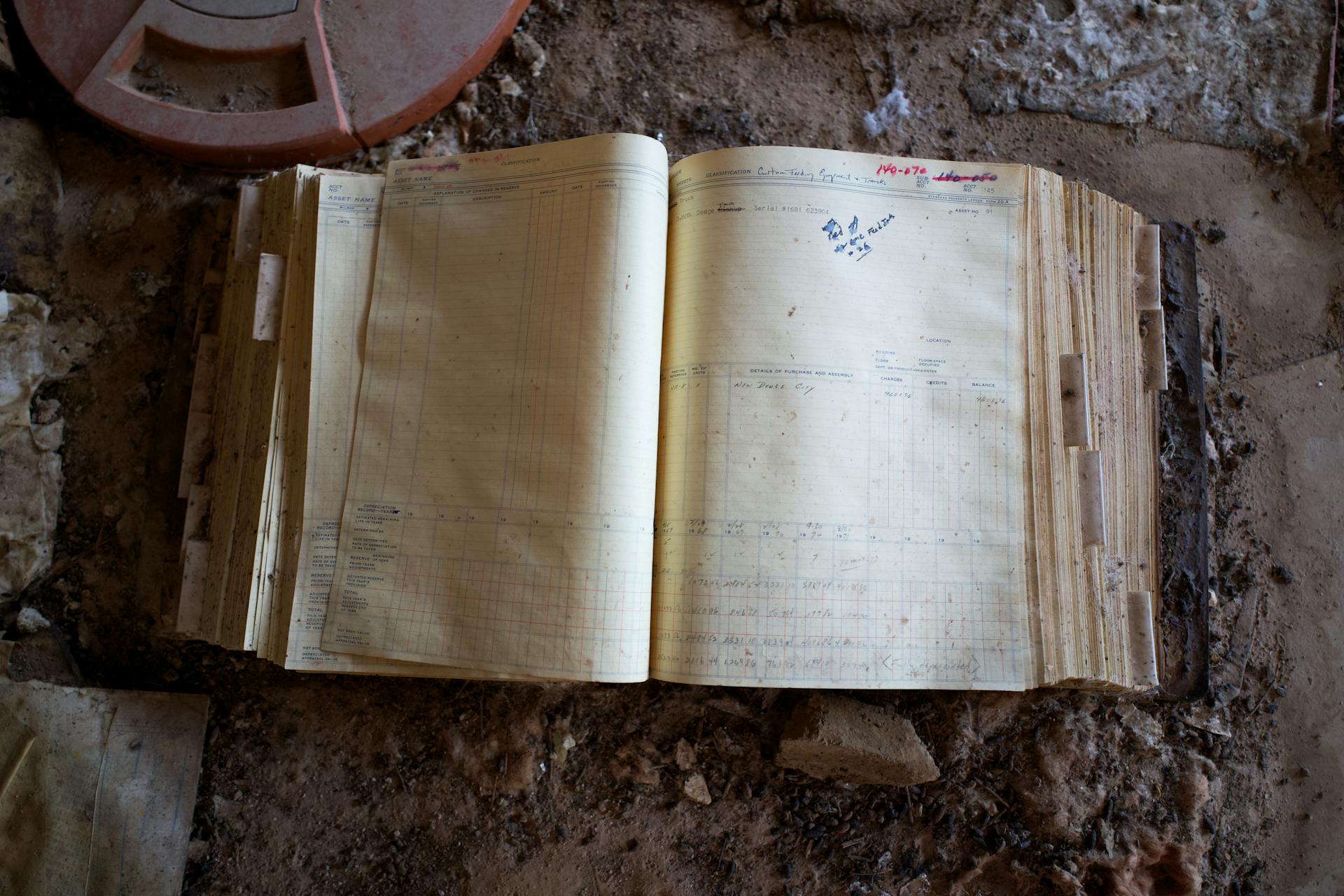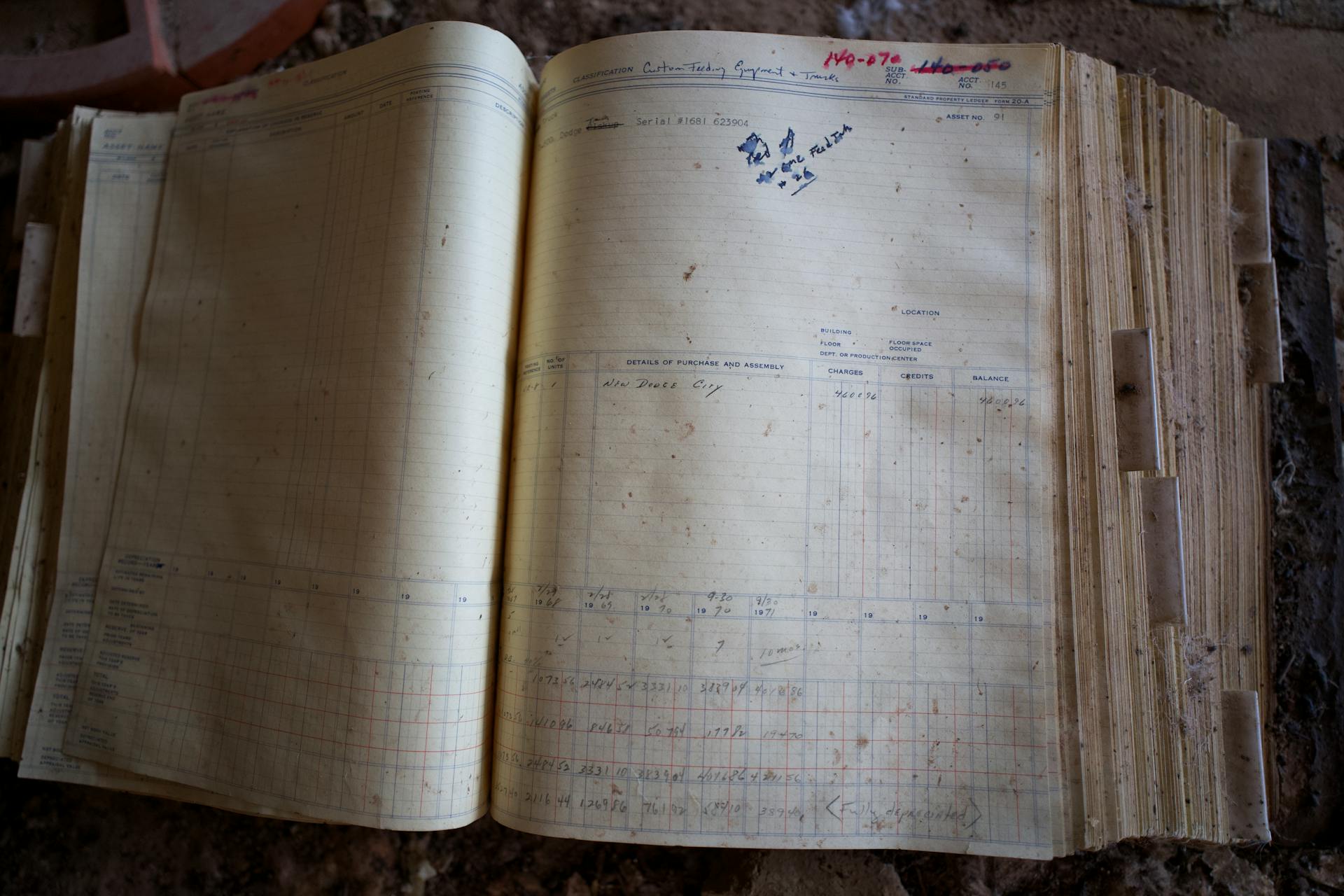
Balancing books for a small business can be a daunting task, but it's essential for making informed financial decisions and staying on top of your finances. You need to track every transaction, no matter how small, to get an accurate picture of your business's financial health.
Start by gathering all your financial documents, including invoices, receipts, bank statements, and credit card statements. This will give you a clear understanding of your business's income and expenses.
As you start balancing your books, remember that every transaction should be recorded in a timely manner, ideally on the same day it occurs. This will prevent errors and make it easier to identify any discrepancies.
By following these essential steps, you'll be able to accurately balance your books and make informed decisions about your business's financial future.
A different take: Balance the Books Meaning
Why Is It Important
Bookkeeping is crucial for small businesses to ensure they're not personally held liable for any debts or issues related to their business. Separating business and personal finances is a must.
Accurate financial data is key to making informed decisions about your business. Without bookkeeping, it's difficult to get a clear picture of your business's financial health.
Bookkeeping helps identify mistakes early on by managing transactions and reconciliation. This can avoid financial issues later on, which is a huge relief.
Simplifying business finances by streamlining tax processes and working with tax professionals can save money. It's a great way to reduce stress and increase efficiency.
Keeping an eye on business financial health identifies ways to improve or change processes. This can lead to growth and success.
Here are some key benefits of bookkeeping for small businesses:
- Being able to better plan and budget for the fiscal year
- Making tax season easier to manage
- Records and data provide the insight to make critical business decisions
Bookkeeping also helps with organizing documents and records, making it easier to apply for a business loan or buy new equipment.
Setting Up Bookkeeping
Setting up bookkeeping is a crucial step in balancing your small business's books. This process often starts with setting up accounting software, which typically involves entering your business's information and connecting your business bank accounts.
You'll also need to give your accountant access to the software so they can make necessary adjustments and check for errors. This is a key part of the setup process.
If this caught your attention, see: Top Billing Software for Small Business
Basic Terms
Let's start with some basic terms to get you set up with bookkeeping.
GAAP stands for Generally Accepted Accounting Principles, which are the financial recognition rules most U.S. businesses follow when preparing financial statements.
These principles aim to make financial reporting accurate and consistent while promoting transparency.
GAAP instructs the timing for recording revenue and expenses, which is crucial for accurate financial reporting.
Your business's accounting method determines which GAAP requirements you need to follow.
General Ledger
A general ledger is the entire record of all company transactions, including expenses, sales, debit, and credit. This comprehensive record is used to make financial statements.
It's a list of all the different accounts and transactions of your business, organized categorically into income, assets, expenditures, and liabilities. This categorization helps you keep track of your finances and make sense of your company's financial situation.
The general ledger is a crucial part of your bookkeeping system, and it's essential to keep it up to date and accurate. This will ensure that your financial statements are reliable and trustworthy.
Here are the main components of a general ledger:
- Income: This includes all the money your business earns from sales, services, and other sources.
- Assets: This includes all the resources your business owns, such as cash, inventory, and equipment.
- Expenditures: This includes all the money your business spends on expenses, such as rent, utilities, and supplies.
- Liabilities: This includes all the debts your business owes, such as loans and credit cards.
Set Up
To set up bookkeeping, you need to set up accounting software. This involves entering your business's information, such as its name, address, and tax ID number.
You'll also need to connect your business bank accounts to the software, which allows you to track your income and expenses. This can be done by linking your bank accounts to the software through online banking or by manually entering your transactions.
Give your accountant access to the software so they can make necessary adjustments and check for errors.
Expand your knowledge: How to Set up Online Payments for Small Business
Open Separate Bank Account
Having a separate bank account for your business is crucial for setting up a smart accounting and bookkeeping system. This will help you keep your personal expenses detached from your business expenses.
Opening a business savings and checking account will assist you in efficiently organizing your revenue stream. It's also essential for planning for taxes at the end of the year.
Intriguing read: Best Small Business Brokerage Account
Maintaining separate accounts supports accurate account balances. This will give you a clear picture of your business's financial health.
Using a business credit card instead of your personal account for business transactions is a good idea. This will help you avoid mixing personal and business finances.
Having a separate bank account for your business will prepare you for a smooth tax season.
Track Expenses and Income
Tracking expenses and income is the backbone of any successful small business. It's essential to document all business transactions, including purchase orders, invoices, and other business documents, to identify tax-deductible expenses and create accurate financial statements.
Only record expenses that directly impact your business, such as employee wages, inventory purchases, and utilities, as these are common business tax deductions.
To track expenses, you can use a single-entry or double-entry accounting system. Single-entry accounting records all transactions once, either as an expense or as income, while double-entry accounting enters every transaction twice as both a debit and a credit.
Here are some common business expense categories:
- Employee wages
- Inventory purchases
- Supplies
- Transportation costs
- Utilities
- Vehicle mileage
It's also crucial to reconcile your business transactions regularly to ensure accuracy and prevent errors. Reconcile your business books and bank statements at least monthly to catch any overlooked transactions.
By tracking expenses and income accurately, you'll be able to prepare a profit and loss statement, which helps you understand what types of expenses and income are impacting your bottom line. This will also make tax time easier and help you avoid paying extra on your tax return.
Additional reading: Canada Small Business Tax Rate
Choosing a Method
You'll need to decide between cash and accrual basis accounting, two primary accounting methods used by most companies.
Cash basis accounting records transactions when money changes hands, whereas accrual basis accounting records invoices and bills even if funds haven't been exchanged. Accrual basis is generally recommended and more aligned with generally accepted accounting principles.
You'll also need to choose between single-entry and double-entry accounting systems. Single-entry accounting records transactions once, either as an expense or income, making it suitable for smaller businesses with simple finances.
Single vs Double Entry
Choosing a method for your small business bookkeeping can be a bit overwhelming, but it's an essential step in maintaining accurate and timely financial data. Single-entry accounting is a straightforward method that's suitable for smaller businesses with simple finances.
In single-entry accounting, all transactions are recorded once, either as an expense or as income. This method is great for businesses that don't have significant inventory or equipment involved in their finances.
Single-entry accounting doesn't track the value of your business's assets and liabilities as well as double-entry accounting does, though. It's a simpler system, but it may not provide the most accurate financial snapshot of your business.
Double-entry accounting, on the other hand, enters every transaction twice as both a debit and a credit. This method can prevent bookkeeping errors and provides a more accurate financial snapshot of your business.
Double-entry accounting takes equity, assets, and liabilities into account, in addition to expenses and income. It's a more complicated system, but it's worth the extra effort for a more accurate financial picture.
Additional reading: Invoice Discounting for Small Businesses
Choose an Method

You need to choose an accounting method for your business, and it's essential to make the right decision. There are two main methods: cash accounting and accrual accounting.
Cash accounting records transactions when money changes hands, as seen in Example 2, where a business records revenue when it receives cash, not when it's invoiced. This method is straightforward and suitable for smaller businesses.
Accrual accounting, on the other hand, records transactions when they occur, regardless of when the money is exchanged. As Example 2 explains, this method recognizes revenue when a sale is made, not when the cash is received.
Your business size and requirements will determine which method is best for you. Small businesses with simple finances might prefer single-entry cash accounting, as mentioned in Example 3.
However, if you have a more complex business, accrual accounting might be the better choice, as it provides a more accurate financial snapshot. As Example 4 notes, double-entry accounting is more suitable for businesses with significant inventory or equipment involved in their finances.
Additional reading: Seed Money for Small Business

The accounting method you choose will impact how you manage your finances and how your bookkeeping processes will work. Accrual accounting is generally recommended and more aligned with generally accepted accounting principles, as stated in Example 6.
Ultimately, your choice of accounting method will depend on your business needs and goals. It's essential to consult with a professional CPA to understand and apply GAAP to your financial statements, as mentioned in Example 2.
Recording Transactions
Recording transactions is a crucial step in balancing your books as a small business owner. In the single-entry method, transactions are recorded when cash flows in, and expenses are recorded when cash is given out.
You can record transactions using various methods, including cash, credit card payments, checks, or electronic fund transfers. This is known as cash-basis accounting.
In contrast, the double-entry method records revenue when it's earned, not received, and expenses when they're due, not paid. This requires a more complex system with five accounts: revenue, expenses, equities, assets, and liabilities.
Suggestion: Small Business Cash Flow Problems
To manage transactions effectively, you should import and categorize them properly, reconcile them, and ensure they're recorded according to your entry system and accounting method. This involves comparing your business books and/or bookkeeping software to your bank statements to make sure the information matches.
Reconciling your transactions regularly, at least monthly, can help prevent errors and make the process less overwhelming.
Financial Statements
Creating financial statements is a crucial step in balancing the books for your small business. You'll want to start by generating a balance sheet, which reflects the company's assets, liabilities, and equity on a specific date.
A balance sheet is typically prepared at the end of an accounting period, and it provides a snapshot of your business's financial situation at that time. It's often used to determine your business's net worth, which is the value of all your physical and non-physical assets minus your liabilities.
To prepare a balance sheet, you'll need to include all your assets, such as cash, accounts receivable, and inventory, as well as your liabilities, like accounts payable and loans. Your equity section will show your net worth, which is the value of your business's assets minus its liabilities.
Discover more: How to Value an Insurance Book of Business
You can also use financial ratios to analyze your balance sheet. For example, the Current Ratio is a formula used to determine if you'll be able to meet your financial obligations within the next year. It's calculated by taking Current Assets and dividing by Current Liabilities.
Here are some common financial statements that you'll want to prepare:
- Balance sheet: reflects the company's assets, liabilities, and equity on a specific date
- Income statement: reports the company's income and expenses for a period
- Statement of cash flows: reports the sources of cash receipts and expenditures during a period
These financial statements will give you a clear picture of your business's financial health and help you make informed decisions about your company's future.
Review Your Statements
Reviewing your financial statements is a crucial step in understanding your business's health. You can find this information in your balance sheet, income statement, and cash flow statement.
The assets section of your balance sheet tells you how much value your business has, while the liabilities section tells you how much money you owe. The equity section gives you the net worth of your business.
You can use financial ratios to get more insight into your business. For example, the Current Ratio is a formula used to determine if you'll be able to meet your financial obligations within the next year.
If this caught your attention, see: Balance the Books
Your income statement shows you how much your business is earning and spending, and ultimately, what your bottom line is. You can also use financial ratios here to dive deeper into your profit and loss statement.
A good gross profit margin is generally anything over 25%. This means you have enough income left over after paying off the cost of goods sold.
Your cash flow statement helps you understand how money moves into and out of your business. The cash flow coverage ratio is a good indicator of whether you have enough cash to pay off debts in the short term and the long term.
Reconciling your accounts regularly is essential to ensure accurate financial data. This includes reconciling your credit card and bank account balances to your general ledger.
By reviewing your statements regularly, you can identify trends and make smart business decisions. This can be done quarterly and annually to monitor incoming revenue and spending trends throughout the fiscal year.
Readers also liked: Small Business with Highest Profit Margin
Managing Finances
Managing transactions is a big part of any daily bookkeeping routine, including importing and categorizing transactions properly, reconciling these transactions, and making sure they're recorded according to your entry system and accounting method.
You should keep separate bank accounts for your personal and business finances to support accurate account balances and prepare your business for a smooth tax season. Avoid using your personal account for business transactions – instead, use a business credit card.
To keep the books, you'll need a digital bookkeeping solution, such as a spreadsheet or accounting software, to track incoming payments and expenses that come in and out of your business bank account and credit card.
Monitor Your Cash Flow
Managing your finances is like keeping track of your daily expenses, but for your business. You need to monitor your cash flow to stay on top of things.
A cash flow statement is a crucial tool for any business owner. It helps you understand where your money is coming from and where it's going. You can use a spreadsheet or accounting software to create a cash flow statement.
There are three main parts to a cash flow statement: cash from operations, cash from financing, and cash from investments. These categories help you track the flow of money in and out of your business.
Here are the three main categories of a cash flow statement:
By regularly reviewing your cash flow statement, you can identify areas where you can improve your business's financial health. This can help you make informed decisions about how to allocate your resources and stay ahead of any financial challenges.
Outsource Your Services
You can outsource your bookkeeping services to free up time and resources for your business.
Consider partnering with professional bookkeepers specializing in recordkeeping practices for your industry.
Outsourcing your bookkeeping helps you save bandwidth and resources, allowing you to focus on growing your business instead of organizing receipts and tracking expenses.
You can communicate with an online bookkeeping service completely by email or phone, without having to set aside time to meet in person.
Be sure to discuss the scope of work and compare options to find the right fit for your business.
Consider reading: Bookkeeping Small Business Accounting
Software and Tools
To balance books for your small business, you'll need to set up accounting software, which typically involves entering your business's information, connecting your business bank accounts, and granting access to your accountant.
Accounting software can help with bookkeeping by categorizing transactions, creating and reading financial statements, and providing data for smart money decisions. You can choose from popular options like QuickBooks, FreshBooks, and Xero, or consider outsourcing to bookkeeping and accounting professionals.
Many small business owners find it helpful to use simple bookkeeping software that provides good accounting functions and additional features like invoicing and tax management. LZ Books is a great option, offering a 30-day free trial and affordable subscription plans.
Automating processes can save you valuable time by reducing manual data entry and tracking. For example, you can use a bookkeeping or accounting solution to automatically track and record invoice payments.
Here are some popular accounting software options to consider:
By implementing accounting software and automating processes, you can streamline your bookkeeping and make it easier to balance your books.
Expert Advice
Hiring a team of experts to handle your bookkeeping can be a game-changer for small businesses. You can save time and professional fees by outsourcing your bookkeeping to a reputable company.
With on-demand access to your records, you can quickly monitor your business's financial health. This is especially helpful during tax season or when making big business decisions.
Cloud-based bookkeeping solutions automatically connect to your revenue system, making it easier to stay on top of your finances. No more manual updates or lost documents.
You can access professionals who specialize in your line of business, ensuring you get tailored advice and support. This is particularly important for industries with unique financial regulations.
Budget-friendly pricing means you won't get stuck with a large professional services bill. This is a huge relief for small business owners on a tight budget.
Here are some benefits of outsourcing your bookkeeping:
- On-demand access to your records
- Cloud-based bookkeeping solutions
- Up-to-date reports on your schedule
- Access to professionals who specialize in your line of business
- Budget-friendly pricing
Sources
- https://www.volopay.com/accounting-automation/guide-to-small-business-bookkeeping/
- https://www.nerdwallet.com/article/small-business/small-business-bookkeeping
- https://www.waveapps.com/blog/how-to-do-bookkeeping-for-small-businesses
- https://1800accountant.com/blog/small-business-bookkeeping-best-practices
- https://www.legalzoom.com/articles/simple-bookkeeping-for-small-business-owners
Featured Images: pexels.com


